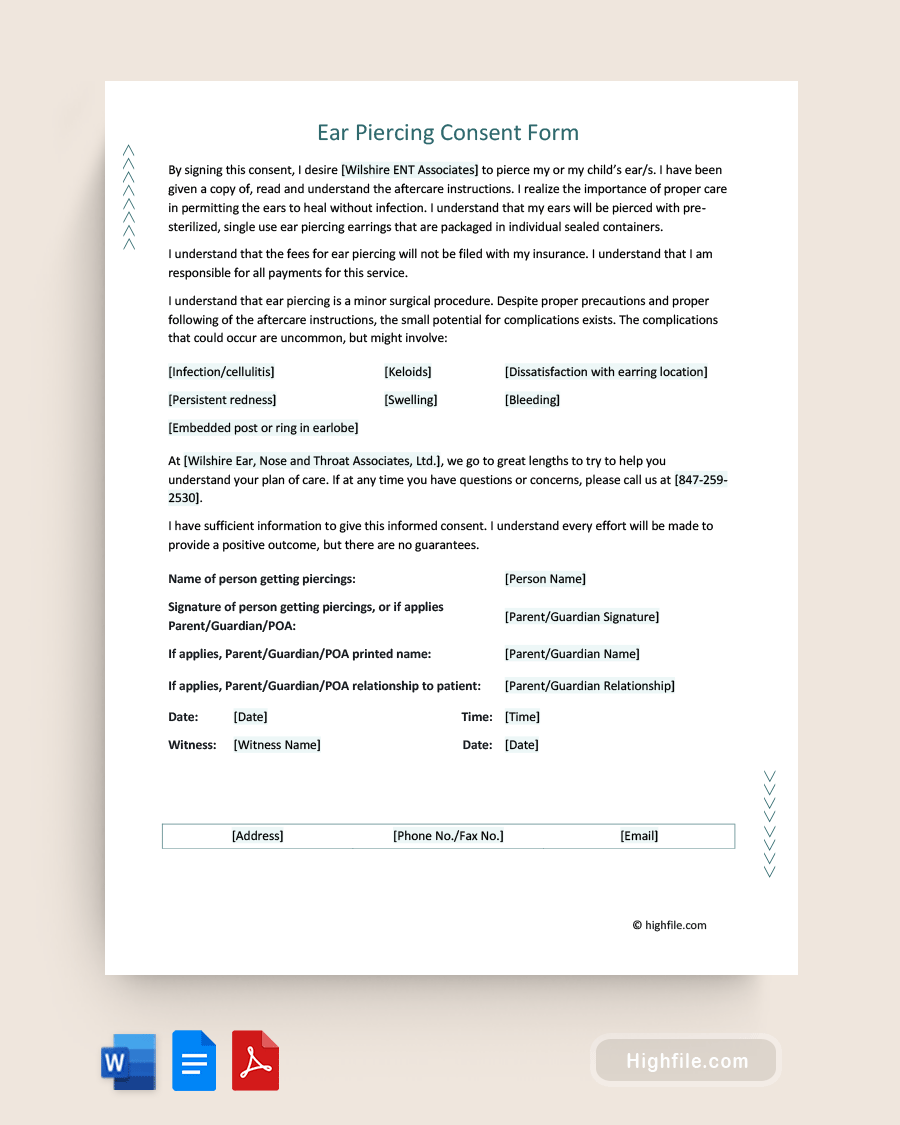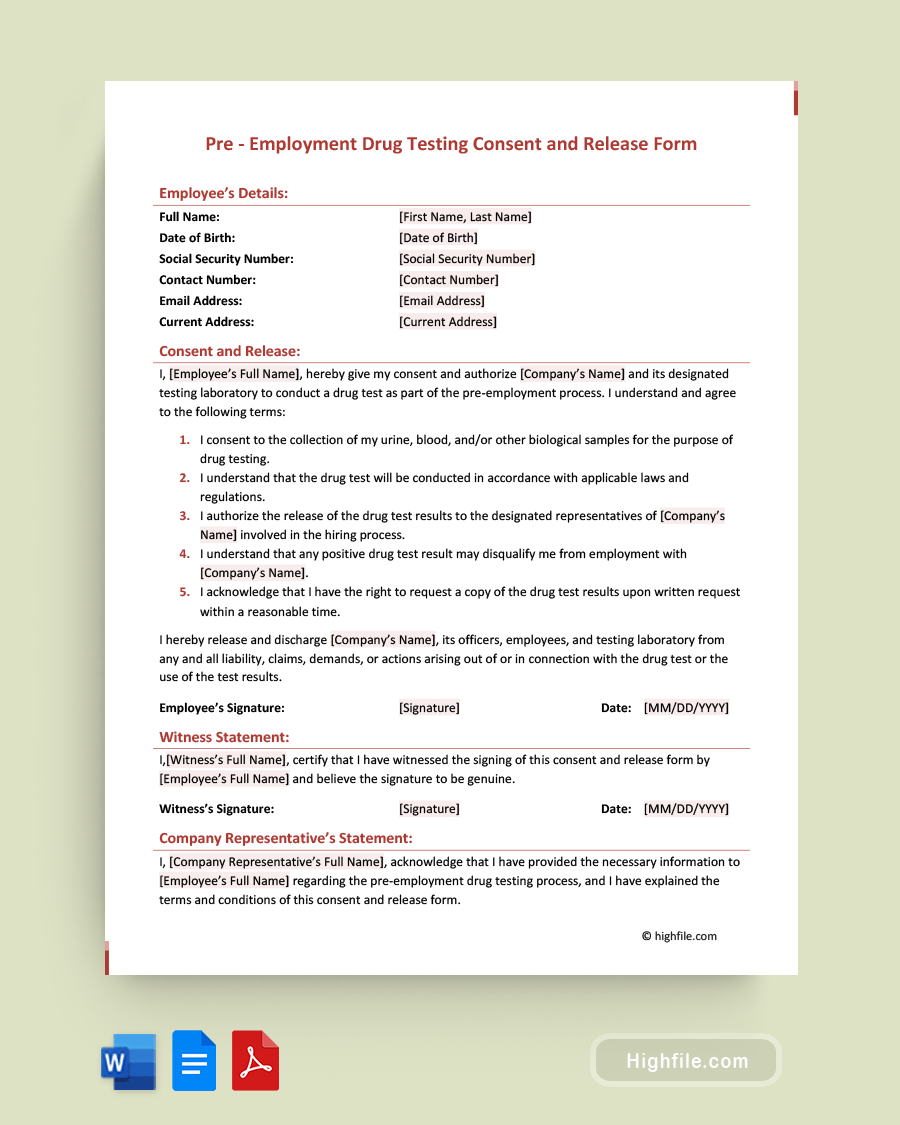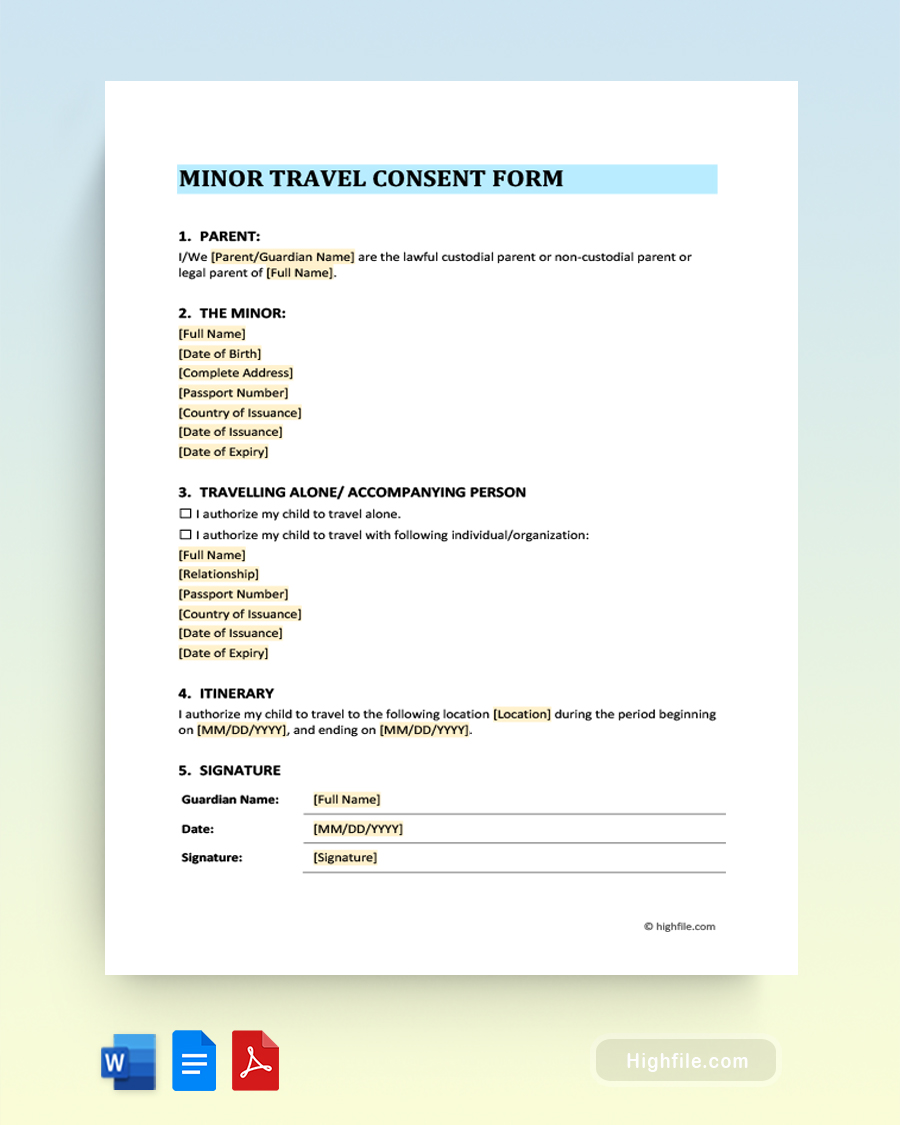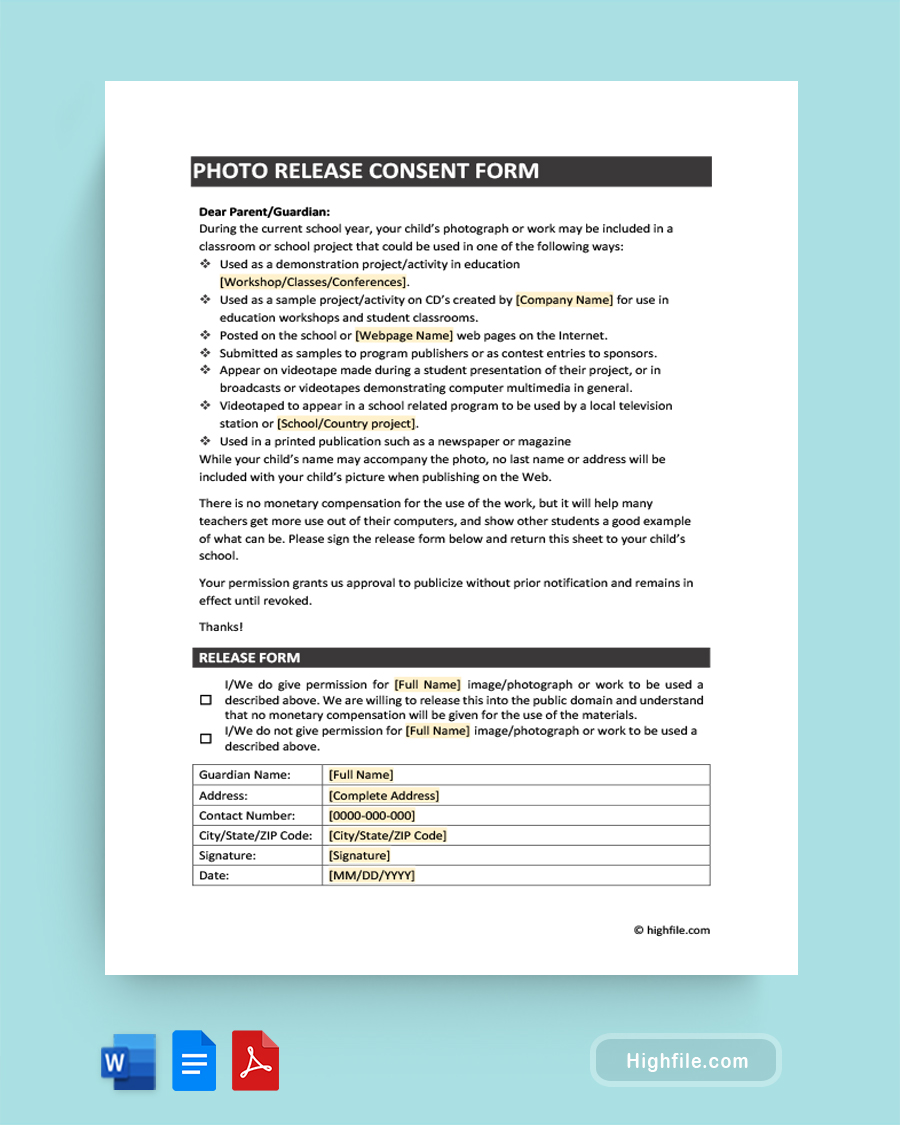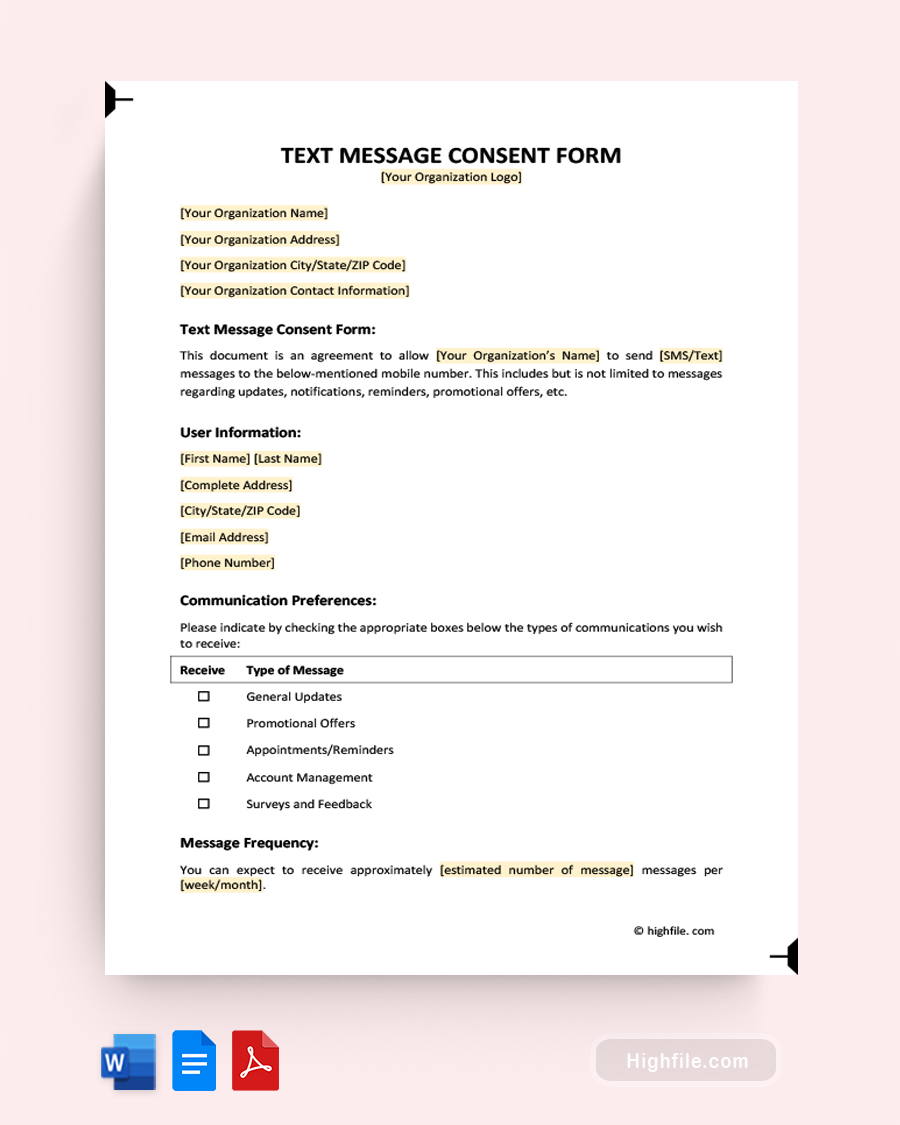Ear piercings are a common sight. Favored by women and men alike, these simple body modifications are practically a right of passage in many areas. However, before you can pierce a new client, you need to get their consent. That’s where an ear piercing consent form template comes in handy. These easy-to-use and time-saving documents can help you compose a custom document in minutes. In this article, you’ll learn everything you need to know about ear piercing consent forms to quickly and efficiently create an outstanding consent form for your business.
What Is an Ear Piercing Consent Form?
An Ear Piercing Consent Form is a document used to obtain authorization from the parent or guardian of a minor for the minor to receive an ear piercing. The form outlines the procedure, risks, and potential complications that may arise from the process. It also includes the parent or guardian’s signature to indicate their consent for the minor to receive the piercing.
Why Is an Ear Piercing Consent Form Important?
Ear piercing consent forms are important for adults to protect the piercer and the customer from any potential legal issues that may arise. The document is designed to ensure both parties are aware of the risks of ear piercing and the need for hygienic materials, practices, and aftercare to avoid infection. The form also serves as a written contract between the piercer and the customer, which outlines the terms and conditions of the ear piercing procedure. By signing a consent form, the customer agrees to follow the piercer’s instructions, accept the risks associated with ear piercing, and acknowledge that they are aware of all potential risks.
These vital documents are also used to document a parent or guardian’s permission for a minor to receive an ear piercing. The form records the minor’s age, the type of piercing, and any other information the piercer or local laws deem relevant. Children need proper parental or guardian consent before receiving an ear piercing, as it can help protect them from any potential risks. Ear piercing consent forms also provide legal protection for piercers and their establishments in the event of a minor experiencing any health complications after receiving a piercing.
Did You Know: Historical factors led directly to modern ear piercing consent forms. Piercings, especially in the ears, have been around for centuries. However, in the mid-20th century, this practice’s popularity markedly increased. Mainstream piercing led to piercing parlors and implementation of safety and sanitation guidelines. The health risks, such as infections, eventually resulted in the need for piercing consent forms that included consent and detailed instructions on how to care for piercings. Additionally, because of its popularity among younger people, laws and piercing consent forms specific to minors were eventually developed and are now widely used.
Essential Elements of an Ear Piercing Consent Form
The essential elements of an ear piercing consent form are relatively simple. This example is for piercings done in a medical setting. It details what to expect in the template and what each section is for.
- Business Logo- This is a common practice for professional business documents.
- List of Medical Professionals and Services- List all the practitioners and the most common services provided.
- Form Title- The title is “Ear Piercing Consent Form.” It should be in large, bold, easy-to-read print at the top.
- Consent Statement- The consent statement shows that the patient or their parent, guardian, or Power of Attorney understands the procedure, hygiene standards, and risks.
- Payment Details- Piercings are not medically necessary. This section explains that insurance will not cover the cost and states that the patient or guardian is responsible for the fees associated with the procedure.
- Complications Statement- This states that complications (listed below) can occur despite best practices.
- List of Potential Complications- This list contains items such as infections, keloids, and dissatisfaction with the location.
- Contact Information- The contact information section is for patients with questions or concerns about this procedure. It should have the contact phone number for inquiries.
- Name of Patient- Print the full name of the person getting their ears pierced.
- Signature- The patient or their representative signs here.
- Parent or Guardian Printed Name- If applicable, print the name of the parent, guardian, or POA signing the document.
- Relationship to Patient- If the patient is a minor or cannot sign for themselves, list the relationship between the signor and the patient.
- Date and Time- This is when the form is signed.
- Witness Signature and Date- Having an impartial witness helps create a solid, legally binding document.
- Facility or Practice Address and Information- You can list a motto, locations, addresses, or other relevant information in small print at the bottom of the page.
Pro Tip: An optional introduction can be added to your form to explain its intent. Here is an example you can use or modify when filling out your template: The following form includes definitions of standard medical terms and risk factors that both the piercer and customer should be aware of before receiving an ear piercing procedure. The document also outlines how the process will go and provides information about what to expect in the days following the procedure. Both parties need to discuss and agree to the terms in this consent form so that there are no misunderstandings or disagreements later, especially if complications arise.
FAQs
In this section, we’ve answered the most frequently asked questions about ear piercing consent in order to help you make a better quality document from your template. Here you’ll find info about minors getting pierced, health and safety data to include, and much more.
A minor cannot get their ears pierced without parental consent unless they are legally emancipated. It is essential for children to have their parent or guardian’s permission before receiving any type of body modification, such as an ear piercing. An ear piercing consent form helps to ensure that minors are not receiving piercings without their parent or guardian’s knowledge or consent.
An ear piercing consent form should include the following information, though some of it is considered optional depending on where you live:
ᐅ The name of the business doing the piercings.
ᐅ The person receiving the piercing’s name, age, and (optional) contact details.
ᐅ The type of piercing being performed, including the exact location on the ear.
ᐅ Acknowledgement of the potential risks associated with the procedure, such as infection, scarring, or allergic reaction.
ᐅ (Optional) An agreement that the person permitting the procedure consents to allow the piercer to take photographs of the ear and make a video recording.
ᐅ An agreement that the person giving permission agrees not to sue anyone should there be any complications with the procedure, such as an allergic reaction or infection.
ᐅ Acknowledgement that the person receiving will follow aftercare instructions and understands what they should do if they feel pain or discomfort during healing, such as how to use ear drops, ice packs, antibiotic ointments, and painkillers.
ᐅ The date and signature
In some states, it is legal for minors to get an ear piercing without a parent or guardian present if they have a signed consent form. Each state has different laws regarding children and body piercings, so it is essential to check your local laws before getting an ear piercing without a parent or guardian present. Some states require the parent or guardian to be present at the time of the piercing, while others only require the parent or guardian’s signature on the consent form. However, the signed consent form must be notarized in some cases, or another adult may accompany the minor.
Health and safety information that should be provided alongside the consent form for ear piercing clients includes:
ᐅ Information about the risks associated with ear piercing, such as infection, pain, and allergic reactions.
ᐅ Instructions on caring for the pierced area should emphasize not swimming or bathing in the water while wearing earrings and cleaning with a mild soap and water solution to avoid unwanted contact with other bacteria in the tub or shower.
ᐅ Details of the materials used in the piercing process, such as the type of needle and jewelry.
ᐅ Information on the qualifications and experience of the piercer.
ᐅ Details of any aftercare products that may be recommended.
ᐅ An explanation of what to do in the case of an emergency.
Depending on the state or country where it is performed, there are specific, highly variable legal requirements for ear piercing consent forms. For example, in the United States, each state has its own laws and regulations regarding ear piercing consent forms. For instance, in California, any person under 18 must have a signed consent form from a parent or legal guardian before being allowed to get their ears pierced. The form must include the name and address of the piercing studio, a description of the procedure, the associated risks and benefits, and an acknowledgment that the parent or guardian has informed their child of these risks and benefits. Additionally, the piercing studio must provide the parent or guardian with detailed information about aftercare instructions. The consent form must be signed and dated by the parent or guardian.
Final Thoughts
Clients should always sign an ear piercing consent form to protect themselves, the business, and the individual piercer. The consent form outlines the risks and responsibilities associated with ear piercing and provides an opportunity for clients to ask any questions they may have. It also serves as a record of the agreement between the client and the establishment, which can be used in case of any legal disputes. Additionally, signing a consent form ensures the client is aware of any health code regulations or safety guidelines that must be followed. Finally, a consent form helps to protect the establishment from any potential liability issues that may arise from the piercing process. By using a professionally designed ear piercing consent form template, you can quickly and easily develop a legally compliant and comprehensive form for your clientele.
